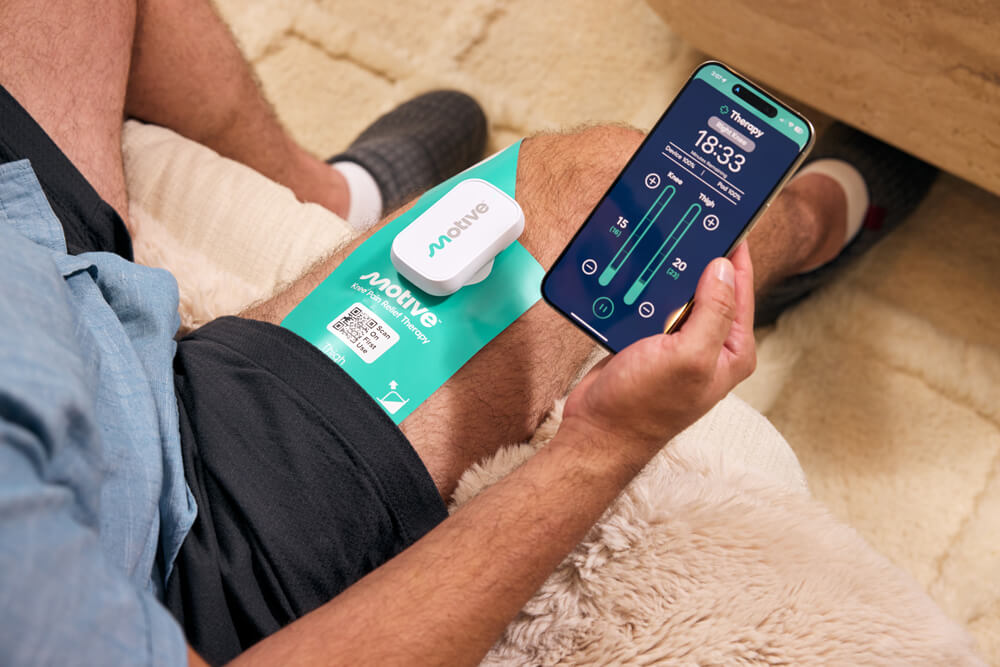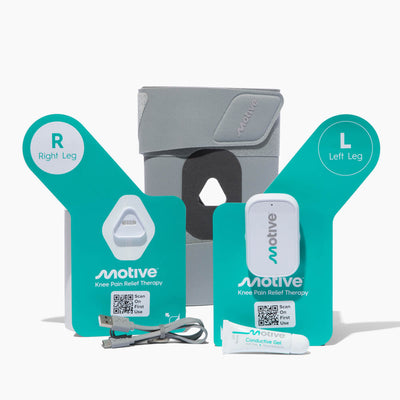
Yoga is a transformative practice, and studies show that 12 weeks of practice offer significant benefits for those suffering from knee pain, stiffness, or limited mobility. Whether you're a beginner or have been practicing for years, incorporating yoga into your daily routine can help manage conditions like osteoarthritis and chronic knee pain, enhancing overall mobility and quality of life.
In this article, we will delve into how specific yoga poses and routines can be tailored to alleviate knee discomfort, improve joint stability, and promote long-term health. Alongside yoga, we'll discuss how integrating other management strategies, including the use of innovative devices like the Motive Device, can further enhance your ability to live a pain-free life.
Understanding Knee Pain and Yoga’s Role
Knee pain can originate from various sources, such as early arthritis, sports injuries, or simple overuse. These conditions can lead to discomfort and immobility if not addressed. Yoga aids in alleviating knee pain by enhancing flexibility, building strength, and improving joint stability. It offers a balanced approach to physical health, which can be particularly beneficial for those experiencing chronic knee issues.
Sources of Knee Pain:
- Early Arthritis: Degenerative changes in the joint that cause pain and stiffness.
- Sports Injuries: Acute damages such as ligament tears or sprains that impact knee function.
- Overuse: Repetitive strain from activities that overload the knee over time.
Benefits of Yoga for Knee Pain:
- Enhances Flexibility: Yoga stretches the muscles and tendons around the knee, increasing range of motion.
- Builds Strength: Targeted poses strengthen the muscles supporting the knee, reducing the load on the joint itself.
- Improves Joint Stability: Yoga helps in stabilizing the knee by balancing the strength of muscles around the joint.
By integrating yoga into your recovery or preventive care routine, you can effectively manage knee pain and enhance your overall joint health, leading to improved mobility and a better quality of life.
With the Motive therapy device, you can experience faster and more enduring relief from knee pain. Explore how this FDA-cleared solution can revolutionize your pain management strategy by visiting our website or contacting us today.
Preparing for Yoga with Knee Pain
Before starting any new yoga regimen, especially if you have persistent knee pain or a history of knee injuries, it's essential to consult with a healthcare provider or a physical therapist. Once you have the green light, gather all the necessary props, like a yoga mat, for a successful and safe yoga practice. Use props like blocks or cushions to modify postures such as the Warrior poses or Chair Pose, ensuring that you maintain a safe standing position that protects your knee joint.
Yoga Poses for Knee Strength and Flexibility
Here are some of the best yoga poses tailored for knee pain relief and joint health:

Chair Pose (Utkatasana):
- Purpose: Strengthens the quadriceps and glutes, important for knee joint stability.
- Technique: Ensure your knees don’t extend past your toes to maintain a 90-degree angle at the knees, helping to prevent undue pressure on the knee joints.

- Bridge Pose (Setu Bandha Sarvangasana):
- Purpose: It helps strengthen the lower back, hip flexors, and thighs, crucial for supporting the kneecap and alleviating lower back pain.
- Benefits: This pose also aids in improving pelvic alignment and core stability, which are vital for overall posture and knee health.

Warrior II (Virabhadrasana II):
- Purpose: It improves leg strength, balance, and endurance.
- Technique: Keep your front knee directly over the ankle to protect the knee and enhance the stretch along the inner thighs, ensuring that the knee is aligned with the second toe to avoid twisting.

Pigeon Pose:
- Purpose: It targets deep tension in the hip flexors and glutes, alleviating stress on knee alignment and function.
- Benefits: Enhances hip and lower back flexibility, reducing strain on knee joints, beneficial for conditions like sciatica.

Child’s Pose:
- Purpose: It relaxes and stretches the back, hips, and thighs, supporting overall knee health by reducing muscle tension.
- Benefits: Calms the mind, improves circulation in the lower extremities, and maintains flexibility in areas affecting knee pain.
By incorporating these poses into your yoga practice, you can address specific areas of weakness and tension that contribute to knee pain, thereby enhancing joint health and mobility in a gentle and effective manner.

Learn More About Motive Knee
Discover MotiveCombining Yoga with Other Knee Pain Management Strategies
To maximize the benefits of your yoga practice for knee pain relief, combine it with other at-home remedies, such as the R.I.C.E method or over-the-counter anti-inflammatory medications. Maintaining a healthy lifestyle, including diet and weight management, is crucial for reducing stress on the knee joint and enhancing the effects of yoga.
Combining Treatments for Enhanced Relief:
- R.I.C.E Method: Utilize Rest, Ice, Compression, and Elevation to manage acute knee pain effectively.
- Anti-inflammatory Medications: Consider over-the-counter options like ibuprofen or naproxen to help reduce inflammation and alleviate pain, following medical advice.
Lifestyle Modifications:
- Diet: Incorporate anti-inflammatory foods such as turmeric, ginger, and omega-3 fatty acids to help reduce inflammation naturally.
- Weight Management: Maintain a healthy weight to decrease the burden on your knees, minimize the risk of exacerbating pain, and facilitate quicker recovery.
These strategies, when combined with regular yoga practice, provide a comprehensive approach to managing knee pain, promoting long-term joint health, and enhancing your overall well-being.
Enhance your yoga routine and overall knee pain management strategy with the Motive therapy device. Discover how this FDA-cleared solution can complement your efforts for greater mobility and pain relief by visiting our website or contacting us today.
When Yoga Isn’t Enough: Seeking Further Help
If yoga and home remedies are insufficient for managing your knee pain, it might be time to seek further professional medical advice. For severe or persistent knee issues, advanced treatment options like physical therapy or even knee replacement surgery may be necessary under the guidance of an orthopedic specialist.
Seeking Professional Medical Advice:
- Consultation: Schedule an appointment with a healthcare provider to discuss persistent knee pain and explore diagnostic options such as X-rays or MRIs to pinpoint the underlying causes.
- Referral to Specialists: Consider a referral to an orthopedic specialist or a physical therapist who can offer specialized treatment plans tailored to your specific knee conditions.
Advanced Treatment Options:
- Physical Therapy: Engage in a professionally guided physical therapy program designed to strengthen the knee and improve mobility without surgery.
- Surgical Intervention: For cases where physical therapy and other non-invasive treatments are ineffective, discuss the possibility of knee replacement surgery with your orthopedic surgeon to restore function and alleviate pain.
- Motive Therapy: Nonsurgical solutions like Motive Therapy can alleviate knee pain without a prescription. Easy-to-use and accessible at home, anyone can use the Motive Device for just 30 minutes a day to experience longer-lasting pain relief.
By incorporating Motive Therapy as part of your comprehensive care plan, you can leverage advanced, FDA-cleared technology to improve the effectiveness of traditional treatments and ensure you are receiving the best possible care for your knee pain. This approach helps to maximize your recovery potential and improve your overall quality of life.
Embrace Yoga for Healthier Knees with Motive
Yoga is an effective method for managing knee pain and improving joint health. By incorporating poses such as High Lunge, Low Lunge, Triangle Pose, and targeted knee-strengthening exercises, you can enhance flexibility and alleviate discomfort. For those seeking additional support, the Motive Device offers targeted, FDA-cleared therapy to further strengthen the muscles around the knee joint, enhancing the benefits of your yoga practice for even greater pain relief and mobility.
Yoga is more than just a physical practice; it's a pathway to a pain-free life, helping you to strengthen your knees and boost your overall well-being. To enhance your knee health even more, consider integrating yoga and the Motive Device into your routine. Visit our website or consult with a healthcare provider to discover how Motive can be a pivotal part of your long-term strategy for knee health, providing lasting relief and improved mobility.





